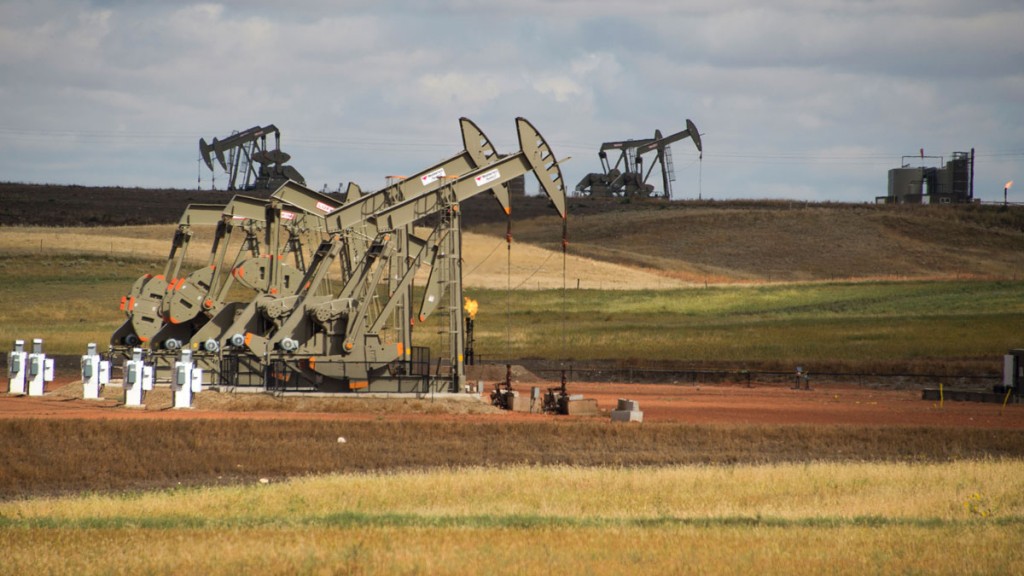
The oil price has been pretty well behaved so far this year.
Compared to the gyrations of 2014 and 2015, oil has taken it easy, meandering around $50 to $55 a barrel.
The global glut seems to be drying up slowly, and prices have been on the recovery path.
But will the period of calm last? Don’t bet on it…
Opec must be desperate – it’s actually sticking to its plans
In November, oil cartel Opec cracked. Led by Saudi Arabia, it decided to cut crude production by around 1.2 million barrels a day starting this year. And – very unusually – it so far seems to be sticking to it.
As the Financial Times reports, it looks as though production in January fell by 1.1 million barrels a day. “This implies more than 90% compliance in the first month of the six-month deal to tackle excess inventories.”
If (and it’s a big if), it manages to stick to this, then there will “no longer be an oil surplus in the second half of the year”, according to Opec. Combine that with higher-than-expected global demand, and you have pretty healthy prospects for the oil price, on the face of it.
This isn’t just Opec marking its own homework. The International Energy Agency came to a similar conclusion last week. The cuts made by Opec have been among “the deepest in the history of Opec output cut initiatives”.
It seems that Saudi Arabia in particular has grown desperate enough to give the oil market a sharp kick in the backside. The big question for the Saudis (and the rest of us) is: what will it actually mean for oil prices?
In short: it’s not going to be easy to keep them riding high.
No more boom and bust? Famous last words
Energy consultant Robert McNally made an interesting point earlier this month in the FT. He notes that almost ever since oil became an important commodity, there have been efforts to control production with the goal of minimising the “boom and bust” nature of the market.
From the Standard Oil Trust, to quotas on American producers from the 1930s to the 1970s, to Opec, “governments and producers… sought to control how much oil gushed from the ground”. Some groups were more successful than others, and some time periods were more stable than others.
But right now there is no “swing producer” – no individual group that has enough clout to even attempt to control the price. Opec screwed up, basically – during the 2000s boom, the oil price went high enough to encourage the exploitation of US shale oil.
Once shale got over the initial hurdles, producers managed to get it out of the ground successfully, and began working on ways to make the process more efficient.
So now Opec isn’t the sole big player anymore. You have the shale producers too. And they are able to move much more quickly than traditional oil market players.
As David Wech of JBC Energy tells the FT: “Opec can tighten the market, but we’ve always doubted they would be permanently able to shift the market balance. The US shale industry has been a game changer because it can respond to price signals in less than a year.”
As a result, reckons McNally, we’ll probably see prices “gyrate between the busts needed to plug wells (well below $30 per barrel) and demand-rationing… booms to well above $100”.
How Donald Trump could flood the market
There’s also another wild card to watch: President Donald Trump’s plans to tax imports. We still don’t know whether or not Trump’s “border tax£ will get off the ground, but if it does, it could have a huge impact on global oil markets.
You see, the US might now be a huge oil producer, but it’s also a massive consumer. It still imports roughly half of its crude oil needs.
If imports of oil are taxed, notes the FT, then the price for crude oil in the US would rise. That in turn would encourage US producers to pump harder and explore for more. As a result, the US would produce and consume more of its own oil.
That would mean the rest of the world’s oil producers would have to find new markets. That in turn “could reignite the price war of the past two years”, as producers compete for business with one another.
And then, what would happen if the US actually became a major energy exporter? The US is already exporting gas, notes Nick Butler in the FT. What if – in the drive to create more manufacturing jobs – Trump goes full steam ahead? “An America fully committed to the development of domestic energy supplies will be a very disruptive force.”
If the US was self-sufficient in oil, and over-producing in other areas – such as natural gas and coal – then Opec’s problems are just beginning.
Of course, we don’t know what Trump’s plans are or how far they’ll get. And we haven’t yet seen how responsive shale really is to shifts in prices. But rig counts are already rising again – producers are getting back in the saddle fast – and it’s undoubtedly true that rising prices are only going to encourage more US shale production.
In short, it looks to me like oil prices haven’t yet gone low enough to cause the level of permanent damage to production capacity that would result in a spectacular rebound to $100 a barrel. And the higher that prices go from here, the more incentive producers have to pump more.
Depending on what direction the US takes, we may well look back on 2017 as the year that the brief truce in the oil wars shattered.